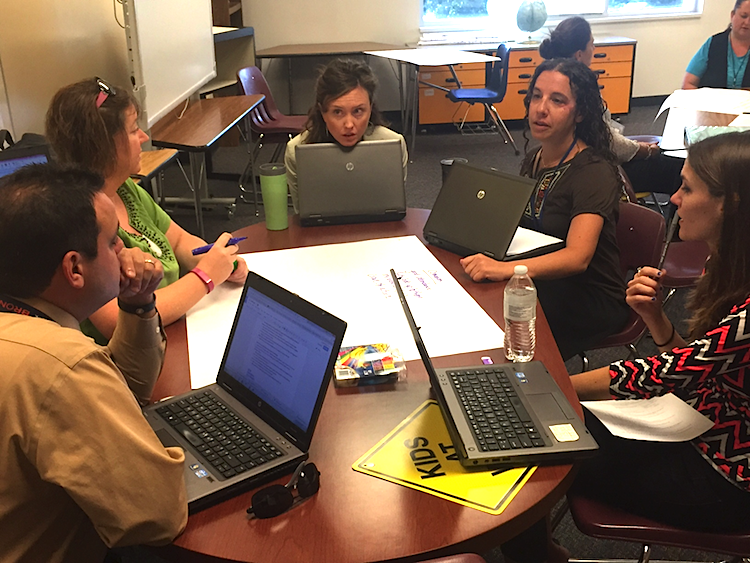How Instructional Rounds Can Lead to Equity and Engagement
By Colin Hynes & Adeyemi Stembridge
At Mrachek Middle School in Aurora, Colorado, our school improvement strategy revolves around the on-going effort to increase our capacity for student-centered, culturally responsive teaching.
Instructional Rounds – an increasingly popular form of collaborative reflection where the observer is the key learner – are a central component of our work.
Our premise has been that student engagement is the critical linchpin of student achievement, and effective instruction requires a reflective teaching mindset that considers students’ needs in academic, social, and cultural contexts.
Ultimately, we want Mrachek to be a school that seeks to meet the needs of all of our learners – which is what we think of as educational equity.
What we’re up to
Since we implemented Instructional Rounds in September of 2014, we’ve found that planning with particular attention to the evidence of behavioral, affective, and cognitive engagement enhances the likelihood that we will create (or as we describe it, “engineer”) responsive teaching and rich learning environments that further draw our students into a meaningful relationship with the school community.
Instructional Rounds have become essential in helping us clarify our shared understanding of how thoughtfully designed instruction supports the engagement of students.
In our version of observer-centered Instructional Rounds, teachers focus on an equity mindset. What do their observations in other classrooms tell them about engaging students equitably and effectively?
Our teachers are becoming more intentional both in terms of their planning and also how they draw from their teaching toolkits to be more responsive to students’ needs during instruction. Many performance metrics, including test data, affirm the benefits of our efforts.
A closer look
Instructional Rounds are a non-evaluative forum for collaborative reflection. Though our middle school and the Aurora Public School District had utilized the instructional rounds model previously, the intentional equity focus we employ centers the teacher-observer (not the teacher being observed) as the primary learner.
Mrachek’s customized model for instructional rounds includes a pre-brief, a classroom observation, and then a debrief.
► In the pre-brief, the teacher guides the observers through the design of the lesson with particular emphasis on both how the instruction is intended to engage students and also where we expect to see the high-rigor moments in the students’ learning experience.
► In the observation phase, our teachers stay for the duration of the instruction so that they can experience the beginning, middle, and end of the lesson to better understand real-time instructional decisions in context.
► The experience culminates with a debrief in which teachers discuss key “snapshots” in the learning experiences. We reflect on the student engagement we saw and what teacher moves supported that engagement. The debrief concludes with observers making actionable commitments for how they themselves will build on their observations and insights into their own practice.
What we want to accomplish
Our goals in supporting the reflection of teachers are to:
- build on our collective understandings of how to best design teaching and learning experiences that create the most equitable and responsive engagement of students;
- provide space in which school staff can identify the underlying mindsets and beliefs most likely to allow some strategies to yield the intended results with specific students and in unique teaching and learning scenarios; and
- embrace the understanding that every teaching and learning situation has its own particular context in which our equity lens must be applied.
We began our work with a voluntary cohort. Our pilot included members of our building administration and at least one representative from each content area and grade level (a group of approximately 15 people in total).
Our initial visits were to the classrooms of teachers within the cohort so that we could establish common understandings, language, and most vitally, trust in the model as a reflective and professional-development exercise.
The success of Instructional Rounds requires that teachers are willing to be vulnerable and to open their classrooms for observation. In order to encourage such openness, our administrators, while participating in the pre-brief and de-brief discussions, excused themselves from the actual classroom observations to further illustrate the non-evaluative aspect of the exercise.
A groundswell of support
At the end of the pilot year, the groundswell of positive momentum allowed for building-wide Instructional Rounds to continue into the subsequent school year.
When in classrooms, we focus our attention on anything that we think of as evidence of students’ engagement. We use objective language to describe what we see and hear from students when we think of them as being authentically engaged in learning.
Through a backward-engineering of sorts, we use snapshots of students’ engagement and associated teacher moves as texts to support our reflection. We ask ourselves, what was working (or not working) for the students in that moment? And further, what do these moments require of us?
As teachers, we think in terms of cultural identity, relationships, students’ assets, and vulnerability – in addition to rigor and engagement. Ultimately, we want to leverage these look-for’s to create rich learning experiences for students throughout the school.
Cookie cutter instruction is not the goal
A significant focus throughout has been to level-set the language we use to describe practices that work especially well for our students. Our goal has not been to make teaching tactics uniform.
We believe in our teachers’ ability to design creative pedagogy and innovative approaches to learning. Our goal is to clarify the lens we use to understand good practices. We develop that lens intentionally around the notion of equity – which means our practices aspire to create rigorous and engaging learning experiences for all of our students with specific attention to the gaps between our highest performing and most vulnerable learners.
The most meaningful instructional experiences are those in which teachers facilitate the connections that students are making with content and understandings. Culturally Responsive instruction is a function of teachers’ capacities for meeting students’ learning needs as they make these powerful connections – and schools that consistently do this well are those that identify and replicate promising practices.
Our clarified beliefs
The Instructional Rounds have helped to clarify these shared beliefs about teaching and learning:
- student engagement is the key prerequisite and indicator of student learning in the classroom;
- context matters – each year, semester, day, class period, etc. is different and ever-changing;
- teachers must be responsive to these varied and changing contexts by leveraging relationships and students’ assets, by honoring their cultural identities, and by the thoughtful design of protective factors for our most vulnerable learners;
- teachers who are able to articulate their planning with specificity are more likely to be responsive to the changing context of the classroom;
- there is no “magic bullet.” While certain instructional strategies are more likely to be successful than others, knowing how to utilize one’s “toolkit” is the key to success (that is, which strategy will be most appropriate in this moment?).
Instructional Rounds provide a forum for reflection that has the potential to impact both the practices and the mindsets of teachers in authentic and sustainable ways. Through collaboration, best practices can be shared, refined and replicated.
Perhaps just as critical is the sharing of insights about students. In this way, teachers become more aware of the different contexts through which students are most likely to experience success. We have found the Instructional Rounds to be a rich space for reflective consideration of the planning, look-for’s, and teacher-supported moves leading to authentic student engagement.
Powerful epiphanies
We began our work with Instructional Rounds looking for a tool to facilitate teacher self-reflection, and while that objective has been met, we found that the core group who piloted the process experienced something more – a shift in mindset through a series of powerful epiphanies about themselves, their students, and their practice.
The Instructional Rounds have become a happy marriage of theory and practice, and we believe the reflective mindset will become more embedded over time and the Instructional Rounds will continue as a cultural characteristic of the Mrachek school community.
_____________
Colin Hynes (@hypercow57) is an assistant principal in Aurora, CO, with 13 years in education spanning middle and high school. His professional journey has taken him from private to charter to neighborhood public schools, from rural to suburban to urban and from New Hampshire to Massachusetts to Colorado. An aspiring school leader, Colin is constantly looking to ask the “right questions” to foster sustained school and student success.
Dr. Adeyemi Stembridge provides technical assistance for school improvement with a specific focus on equity. He works with districts around the country to identify root causes of achievement gaps and formulate pedagogy- and policy-based efforts to redress the underperformance of vulnerable student populations. Follow him on Twitter @DrYemiS.






































